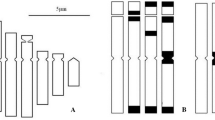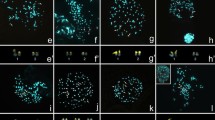Abstract
Somatic metaphase karyotypes were analyzed for 22 diploid species ofEupatorium. The karyotypic comparisons were made using two indices: minimal chromosomal distance (MCD), measuring overall dissimilarities, and chromosomal identity (CI), measuring number of morphologically identical chromosomes between species. The resulting phenograms from these indices are largely compatible. The 22 species cluster into four groups in the phenogram using MCD, and the grouping corresponds well with morphology or geographic distribution into the three N. American groupsEutrochium, Uncasia, Traganthes, and the E. Asian group. These results suggest that karyotypes in perennialEupatorium have been considerably conservative and changed not through large chromosomal mutations but through small chromosomal mutations gradually fixed.
Similar content being viewed by others
References
Atchley, W. R., 1972: The chromosome karyotype in estimation of lineage relationships. — Syst. Zool.21: 199–209.
Babcock, E. B., 1947: The genusCrepis 1, 2. — Univ. Calif. Publ. Bot.21–22: 1–1030.
Bianchi, N. O., Merani, S., 1984: Cytogenetics of South American akodont rodents (Cricetidae). 10. Karyological distances at generic and intergeneric levels. — J. Mammal.65: 206–219.
—,López Camelo, J. S., Olivero, O. A., Lopretto, E. C., 1988: An equation to determine the index of karyological conservatism among phylogenetically related species. — Caryologia41: 9–15.
Boufford, D. E., Spongberg, S. A., 1983: Eastern Asian—eastern North American phytogeographical relationships — a history from the time ofLinnaeus to the twentieth century. — Ann. Missouri Bot. Gard.70: 423–439.
Brandham, P. E., 1983: Evolution in a stable chromosome system. — InBrandham, P. E., Bennett, M. D., (Eds.): Kew chromosome conference 2, pp. 251–260. — London: Allen & Unwin.
Denver Study Group, 1960: A proposed standard system of nomenclature of human mitotic chromosomes. — Acta Gen.10: 322–328.
Duncan, T., Smith, A. R., 1978: Primary basic chromosome numbers in ferns: facts or fantasies? — Syst. Bot.3: 105–114.
Ehrendorfer, F., 1983: Quantitative and qualitative differentiation of nuclear DNA in relation to plant systematics and evolution. — InFairbrothers, D. E., (Ed.): Proteins and nucleic acids in plant systematics, pp. 3–35. — Berlin, Heidelberg, New York, Tokyo: Springer.
—, 1986: Chromosomal differentiation and evolution in angiosperm groups. — InIwatsuki, K., Raven, P. H., Bock, W. J., (Eds.): Modern aspects of species, pp. 59–86. — Tokyo: University of Tokyo Press.
Graham, A., 1972: Outline of the origin and historical recognition of floristic affinities between Asia and eastern North America. — InGraham, A., (Ed.): Floristics and palaeofloristics of Asia and western North America, pp. 1–18. — Amsterdam: Elsevier.
Huziwara, Y., 1956: Karyotype analysis in some genera ofCompositae 1. Karyotype of JapaneseEupatorium. — Cytologia21: 114–123.
—, 1968: Chromosome studies on some species ofAngiospermae 2. — La Kromosomo72–73: 2360–2363.
Jackson, R. C., 1962: Interspecific hybridization inHaplopappus and its bearing on chromosome evolution in theBlepharadon section. — Amer. J. Bot.49: 119–132.
—, 1965: A cytogenetic study of a three-paired race ofHaplopappus gracilis. — Amer. J. Bot.52: 946–953.
—, 1971: The karyotype in systematics. — Ann. Rev. Ecol. Syst.2: 327–368.
Kawahara, T., Yahara, T., Watanabe, K., 1989: Distribution of sexual and agamospermous populations in AsianEupatorium (Compositae). — Pl. Sp. Biol.4: 37–46.
Kawano, S., 1961: Brief note on the chromosomes of some Japanese plants. — Japan. J. Bot.36: 285–288.
King, R. M., Robinson, H., 1970a: Studies in theEupatorieae (Compositae) 25. A new genusEupatoriadelphus. — Phytologia19: 431–432.
—, —, 1970b:Eupatorium, a composite genus of Arcto-Tertiary distribution. — Taxon19: 769–774.
—, —, 1987: The genera of theEupatorieae (Asteraceae): — Monogr. Syst. Bot. Missouri Bot. Gard.22: 1–581.
Kitamura, S., 1961: Supplementa et emendanda adCompositae Japonicae 2. — Acta Phytotax. Geobot.19: 16–17.
Levan, A., Frenda, K., Sandberg, A. A., 1964: Nomenclature for centromeric position on chromosomes. — Hereditas52: 201–220.
Li, H. L., 1952: Floristic relationships between eastern Asia and eastern North America. — Trans. Amer. Phil. Soc.42: 371–429.
Meerow, A. W., 1987: Chromosome cytology ofeucharis, Caliphruria, andUrceolina (Amaryllidaceae). — Amer. J. Bot.74: 1560–1576.
Rohlf, F. J., 1986: NTSYS-pc (Numerical taxonomy and multivariate analysis system for the IBM PC microcomputer and compatibles), ver. 1.01. — Setauket, New York: Applied Biostatistics, Inc.
Schweizer, D., Ehrendorfer, F., 1976: Giemsa banded karyotypes, systematics, and evolution inAnacyclus (Asteraceae-Anthemideae). — Pl. Syst. Evol.126: 107–148.
Stebbins, G. L., 1971: Chromosomal evolution in higher plants. — London: Arnold.
Tobgy, H. A., 1943: A cytological study ofCrepis fulginosa, C. neglecta, and their F1 hybrid, and its bearing on the mechanism of phylogenetic reduction in chromosome number. — J. Genet.45: 67–111.
Watanabe, K., Fukuhara, T., Huziwara, Y., 1982: Studies on the Asian eupatorias. 1.Eupatorium chinense var.simplicifolium from the Rokko Mountains. — Bot. Mag. (Tokyo)95: 261–280.
—,Smith-White, S., 1987: Phyletic and evolutionary relationships ofBrachyscome lineariloba (Compositae). — Pl. Syst. Evol.157: 121–141.
Author information
Authors and Affiliations
Rights and permissions
About this article
Cite this article
Watanabe, K., Ito, M., Yahara, T. et al. Numerical analyses of karyotypic diversity in the genusEupatorium (Compositae, Eupatorieae). Pl Syst Evol 170, 215–228 (1990). https://doi.org/10.1007/BF00937705
Received:
Issue Date:
DOI: https://doi.org/10.1007/BF00937705




